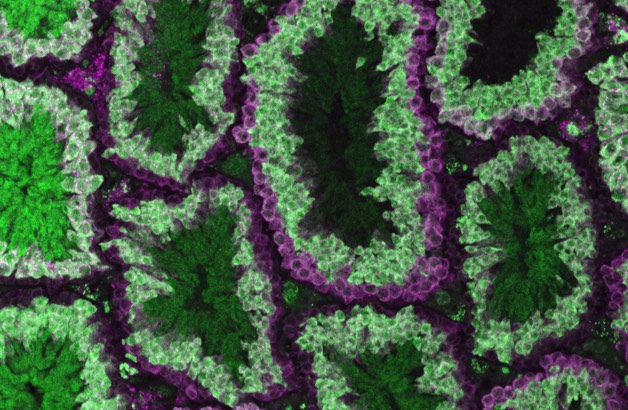Nearly three years ago University of California San Diego researchers announced the world’s first CRISPR-Cas9 genetic editing-based approach to controlling inheritance in mammals.
The 2019 achievement described research led by then-UC San Diego graduate student Hannah Grunwald and Associate Professor Kimberly Cooper, who employed “active genetics” editing, a technology developed at UC San Diego, to influence the inheritance of genes in mice. This gives biologists the ability to control which copy of a gene is inherited from one generation to another with potential for a variety of biomedical and environmental applications. The research succeeded in female mice but not in males, presumably due to differences in the timing of key events in females and males during the reproductive cell division process known as meiosis.
Led by graduate student Alexander Weitzel, Grunwald, Cooper and their colleagues have now succeeded in developing CRISPR-Cas9 inheritance control in male mice by shifting the gene editing window to more closely match the timing of meiosis in both sexes. Their results were published December 23, 2021 in the journal PLOS Biology.
The achievement advances the prospects of scientists being able to use genetic editing for new laboratory models in an array of research pursuits, from investigations of human disease to therapeutic drug design to invasive species removal.
“For these gene conversion strategies to work in any context—in the lab or in wild populations— you need the mechanism of gene conversion to work in both males and females,” said Cooper, associate professor in the Section of Cell and Developmental Biology, Division of Biological Sciences. “It seems as though the reason this process was previously working in females is because we were closer to the female meiotic window. Now that we’ve moved Cas9 expression to within the meiotic window in males, it works in them too.”
As before, the researchers used an active genetic DNA element that copies genetic information, known as a “CopyCat,” in mice. During the new experiments, the researchers used the regulatory DNA of Spo11, a gene known to be involved in meiosis in males and females, to control expression of the Cas9 protein that cuts DNA.
“Since timing is so important, hitting that meiosis sweet spot was important for male gene conversion,” said Cooper.
As before, getting the new strategy to succeed came with some limitations. In order to land in the male timing window, while staying within the female timing window, the gene conversion process became less effective, likely because of a lower level of Cas9 expression. Current research in Cooper’s lab is investigating this issue.
“While showing that CRISPR-Cas9-mediated gene conversion is possible in both male and female mouse germlines, our work reveals nuances that differ from insects and that must be considered for further refinement and implementation in rodents,” the authors note in the paper.
Relatedly, Grunwald, Weitzel and Cooper have expanded on their work by publishing a type of instruction manual for other laboratories interested in gene conversion in mammals.
In a Nature Protocols article, also published December 23, the researchers describe details of their CRISPR-Cas9 gene conversion system and potential for use in the laboratory and in wild rodent populations. They lay out the technical hurdles that must be overcome before scientists implement such strategies for applications in any context. Broadening this system, the authors write, would expand laboratory efficiencies, which hold benefits on several levels.
“If successfully implemented in the laboratory, CRISPR-Cas9-mediated gene conversion promises to save money, time and animal lives, while simultaneously expanding our ability to investigate some of the most complex developmental questions and most prevalent human diseases,” they say in the paper.















